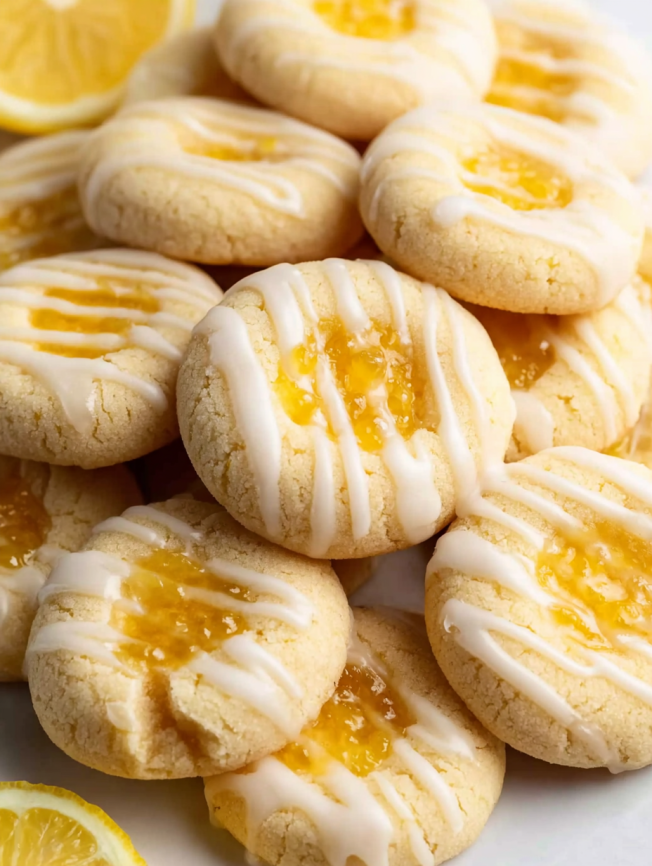Nothing captures the essence of sunshine quite like a perfect lemon thumbprint cookie. These delicate, buttery treats have been my go-to recipe whenever I need to brighten someone’s day or add a burst of citrus joy to any gathering. The first time I bit into one of these cookies, I was transported to a summer afternoon filled with the scent of fresh lemons and the warmth of home baking.
What makes these cookies truly special is their triple dose of lemon flavor – fresh zest and juice in the dough, tangy lemon curd nestled in the center, and a bright lemon glaze drizzled on top. The soft, tender texture comes from a rich butter cookie base that practically melts on your tongue, while the sweet-tart contrast keeps you reaching for just one more.
These aren’t your typical hard thumbprint cookies that crumble when you bite them. Instead, this recipe creates incredibly soft, almost cake-like cookies that maintain their shape beautifully while delivering an intensely satisfying eating experience.
Why These Lemon Thumbprints Will Become Your New Obsession
Irresistible Texture Combination
The magic of these cookies lies in their perfect textural contrast. The tender, buttery cookie base provides a soft foundation, while the smooth lemon curd creates a luxurious center that bursts with flavor. Meanwhile, the delicate lemon glaze adds just enough sweetness to balance the tartness without overwhelming the bright citrus notes.
Triple Lemon Flavor Impact
Unlike cookies that promise lemon flavor but deliver disappointment, these thumbprints pack an authentic citrus punch. Fresh lemon zest infuses the dough with aromatic oils, while lemon juice adds brightness. Subsequently, the lemon curd filling intensifies the citrus experience, and the lemon glaze provides the perfect finishing touch.
Impressive Presentation with Simple Technique
These cookies look incredibly sophisticated and bakery-worthy, yet the technique is surprisingly approachable for home bakers. The thumbprint method creates charming individual wells that showcase the golden lemon curd beautifully. Furthermore, the glossy glaze drizzle adds an elegant finishing touch that makes these cookies perfect for gift-giving or special occasions.
Make-Ahead Friendly Design
The long chilling requirement actually works in your favor for advance planning. You can prepare the dough up to three days ahead, making these ideal for holiday baking or party preparation when time management is crucial.
Essential Ingredients for Citrus Cookie Success
Cookie Dough Foundation
- 2¼ cups (281g) all-purpose flour, spooned and leveled
- 1 tablespoon (8g) cornstarch
- ¼ teaspoon salt
- 14 tablespoons (200g) unsalted butter, softened
- ¾ cup (150g) granulated sugar
- 1 tablespoon fresh lemon zest
- 1 tablespoon fresh lemon juice
- 1 large egg, room temperature
- 1 teaspoon vanilla bean paste (or extract)
Coating and Filling Components
- ½ cup (100g) granulated sugar for rolling
- ½ cup (140g) lemon curd (homemade or store-bought)
Bright Lemon Icing
- 1 cup (120g) confectioners’ sugar
- 2 tablespoons fresh lemon juice
Ingredient Quality Notes
Fresh lemons make an enormous difference in these cookies – bottled lemon juice simply can’t match the bright, complex flavor of freshly squeezed juice and zest. The cornstarch addition creates extra tenderness, while vanilla bean paste provides both flavor and visual appeal with its tiny black specks.
Step-by-Step Instructions for Perfect Results
Dough Preparation Phase
Step 1: Begin by whisking together flour, cornstarch, and salt in a medium bowl until evenly combined. This dry mixture can be set aside while you work on the wet ingredients.
Step 2: Using a large bowl and either handheld or stand mixer fitted with paddle attachment, cream the softened butter and granulated sugar on medium-high speed for about 1 minute until light and fluffy. The mixture should noticeably increase in volume and become paler in color.
Step 3: Add the fresh lemon zest, lemon juice, egg, and vanilla bean paste to the creamed mixture. Beat on high speed for approximately 1 minute until well combined. Don’t worry if the mixture appears curdled at this point – this is completely normal and will smooth out once you incorporate the dry ingredients.
Combining and Chilling
Step 4: Add the flour mixture to the wet ingredients and mix on low speed just until combined. The resulting dough will be very soft and creamy – much softer than typical cookie dough. Cover the bowl tightly and refrigerate for at least 3 hours, though overnight chilling produces even better results.
Shaping and Filling Process
Step 5: Line large baking sheets with parchment paper or silicone baking mats, then clear space in your refrigerator for the shaped cookies. Place the remaining granulated sugar in a small bowl for rolling the cookie balls.
Step 6: Working with the well-chilled dough, scoop approximately 1 tablespoon (18g) portions and roll them into smooth balls. Roll each ball thoroughly in granulated sugar, ensuring complete coverage, then place them 2 inches apart on the prepared baking sheets.
Step 7: Use your thumb (or the back of a small spoon) to create deep indentations in the center of each cookie ball. Make these impressions fairly pronounced, as they’ll puff up slightly during baking. Fill each indentation with about ½ teaspoon of lemon curd.
Baking to Golden Perfection
Step 8: Preheat your oven to 350°F (177°C) while placing the shaped cookies in the refrigerator. This additional chilling step prevents excessive spreading and helps maintain the cookies’ shape during baking.
Step 9: Bake the chilled cookies for 12-13 minutes, or until the edges appear set and are just beginning to show the faintest golden color. Avoid overbaking, as these cookies continue cooking slightly from residual heat after removal from the oven.
Step 10: Allow cookies to cool on the baking sheet for 5 minutes before carefully transferring them to a wire rack for complete cooling. This brief resting period prevents the soft cookies from breaking during transfer.
Final Glazing Touch
Step 11: While cookies cool, whisk together confectioners’ sugar and fresh lemon juice until smooth. Drizzle this glaze over the completely cooled cookies using a spoon, fork, or squeeze bottle for more precise control. The icing will set within 30 minutes at room temperature.

Creative Serving and Presentation Ideas
Elegant Tea Party Display
Arrange these lemon thumbprints on vintage china plates or tiered serving stands for sophisticated afternoon tea presentations. Their bright yellow centers create beautiful visual appeal alongside delicate teacups and fresh flowers. The citrus flavors pair wonderfully with both black teas and herbal varieties.
Seasonal Gift Giving
Package these cookies in clear cellophane bags tied with cheerful yellow ribbons for delightful homemade gifts. Their professional appearance and incredible flavor make them perfect for teacher appreciation, hostess gifts, or holiday cookie exchanges. The two-week shelf life ensures they’ll stay fresh during gift-giving season.
Spring and Summer Celebrations
These cookies are ideal for Easter brunch, Mother’s Day gatherings, or graduation parties where bright, cheerful flavors are appreciated. Their sunny appearance naturally complements spring and summer color schemes, while the refreshing lemon flavor provides a light finish to heavier meals.
Delicious Flavor Variations to Explore
Mixed Citrus Medley
Experiment with other citrus fruits by substituting lime or orange zest and juice in the dough. Orange thumbprints filled with orange marmalade and drizzled with orange glaze create a delightful variation, while lime versions offer a more exotic twist perfect for summer entertaining.
Berry-Filled Alternatives
Replace the lemon curd with high-quality raspberry, strawberry, or apricot preserves for fruity variations that still benefit from the lemon glaze. The contrast between berry sweetness and citrus brightness creates complex, sophisticated flavors that appeal to diverse tastes.
Chocolate-Drizzled Decadence
For special occasions, try drizzling melted white chocolate over the set lemon glaze. The combination of citrus and white chocolate creates an elegant flavor profile reminiscent of high-end confections, perfect for wedding showers or anniversary celebrations.
Strategic Make-Ahead Planning
Extended Dough Storage
The soft, creamy nature of this dough actually improves with extended chilling. Prepare the dough up to three days in advance, keeping it tightly covered in the refrigerator. This extended chilling time allows flavors to meld and develop, creating even more delicious results.
Freezer-Friendly Options
Both unbaked dough balls and completely finished cookies freeze exceptionally well for up to three months. For unbaked portions, freeze the shaped dough balls before coating in sugar, then thaw for 30 minutes before proceeding with coating, filling, and baking. Finished cookies should be frozen in single layers to protect the delicate glaze.
Efficient Batch Preparation
This recipe doubles beautifully for large gatherings or holiday baking marathons. When making multiple batches, prepare all dough portions first, then proceed with shaping and baking in organized batches to maintain quality and prevent overworking the delicate dough.
Professional Baking Tips for Success
Temperature Control Importance
Room temperature ingredients blend more smoothly, creating better texture in the final cookies. However, the dough must be thoroughly chilled before shaping – warm dough will be too soft to handle and will spread excessively during baking.
Proper Thumbprint Technique
Create deep, well-defined indentations that will hold the lemon curd securely. Shallow impressions may fill in during baking, while overly deep ones can cause the cookies to crack. Practice on a few test cookies to find the right pressure and depth.
Lemon Curd Consistency
Whether using homemade or store-bought lemon curd, ensure it’s thick enough to stay in place during baking. Thin or runny curd may overflow and create messy results. If your curd seems too thin, chill it briefly before filling the cookies.
Important Notes for Optimal Results
Butter Measurement Precision
This recipe specifically calls for 14 tablespoons of butter rather than a full cup (16 tablespoons). This precise measurement prevents overspreading while maintaining the rich, buttery flavor that makes these cookies so special.
Chilling Requirements
Never skip or shortcut the chilling steps – both the initial dough chill and the pre-baking chill are essential for proper texture and shape retention. The soft, rich dough simply cannot be handled properly without adequate chilling time.
Storage Considerations
Store finished cookies in airtight containers at room temperature for up to one week. Layer them carefully between parchment paper to protect the delicate glaze and prevent sticking. Avoid refrigerating finished cookies, as this can make the glaze sticky.

Frequently Asked Questions
Q: Can I use bottled lemon juice instead of fresh? A: While fresh lemon juice provides the best flavor, you can substitute bottled juice in a pinch. However, the bright, complex citrus notes won’t be quite as pronounced. Fresh lemon zest, however, is irreplaceable and provides essential aromatic oils that bottled products cannot match.
Q: What should I do if my dough is too soft to handle even after chilling? A: If your dough remains too soft after the minimum 3-hour chill, continue refrigerating for several more hours or overnight. Room temperature and humidity can affect chilling time. You can also work with smaller portions, keeping the rest chilled while shaping individual batches.
Q: Can I make these cookies without lemon curd? A: Absolutely! High-quality fruit preserves or jams work beautifully as substitutes. Raspberry, apricot, and strawberry are particularly delicious options. Keep the lemon glaze even when using different fillings, as it adds brightness and ties the flavors together.
Q: Why do my cookies spread too much during baking? A: Excessive spreading typically indicates insufficient chilling time or dough that’s too warm when it goes into the oven. Ensure both initial dough chilling and pre-baking chilling steps are followed completely. Also, verify your oven temperature with a separate thermometer, as temperatures that are too low can cause spreading.
Q: How can I achieve clean, professional-looking glaze drizzles? A: For the most controlled drizzling, transfer the glaze to a squeeze bottle or small plastic bag with a corner snipped off. Work quickly while the glaze is at the right consistency – too thick and it won’t drizzle smoothly, too thin and it will run off the cookies.
Q: Can I prepare the lemon curd filling in advance? A: Yes! Homemade lemon curd can be prepared up to one week in advance and stored in the refrigerator. It also freezes well for up to 6 months. Having lemon curd on hand makes assembling these cookies much quicker and easier when you’re ready to bake.

